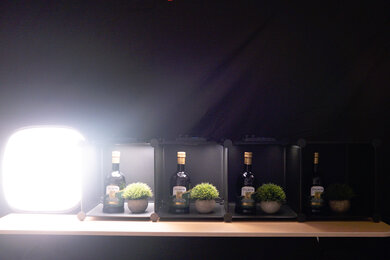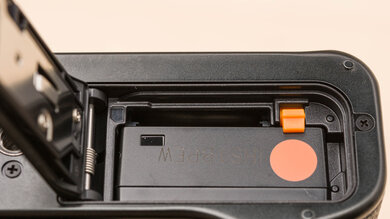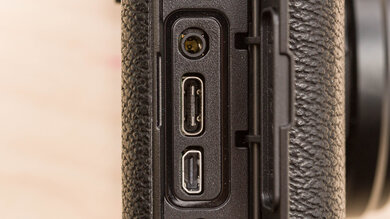The Fujifilm X100V is a premium point-and-shoot with an APS-C sensor and the fifth iteration of Fujifilm's X100 series of compact cameras, beloved by street photographers and enthusiasts everywhere. Upgrading the lens from its predecessor but keeping its classic 35mm full-frame equivalent focal length, Fujifilm has kept true to all the things that work about this formula: a relatively compact body with a retro rangefinder design, dedicated exposure dials for hands-on control, and the pièce de résistance—a hybrid viewfinder that lets you toggle between an optical rangefinder for easier framing and an electronic viewfinder for real-time exposure adjustments.
Our Verdict
The Fujifilm X100V is good for travel photography. While it's pretty big for a point-and-shoot, its compact fixed-lens design is still much smaller than most interchangeable-lens cameras and makes it easy to travel with. Out-of-the-box image quality is excellent, and the camera performs well in low light thanks to its wide-aperture lens and good noise handling. The lens also has a built-in ND filter, so you can use a wider aperture or slower shutter speed on brighter days. Its fixed 35mm-equivalent focal length is well-suited to street scenes and everyday subjects, though it isn't as versatile as a fixed zoom lens for farther-away subjects. Unfortunately, the camera's ergonomics can take some getting used to. Also, while it's mostly weather-sealed, you need to purchase separate accessories for its lens to fully protect against moisture and dust.
- Compact design.
- Impressive build quality.
- Excellent image quality.
- Ergonomics are somewhat lacking.
- Somewhat short battery life.
The Fujifilm X100V is great for landscape photography. Out-of-the-box image quality is amazing, with fantastic noise handling capability and great dynamic range to capture more detail in high-contrast landscapes. The camera also feels solidly built and is partially weather-sealed, though you need to purchase extra accessories to get full weather-sealing. The built-in ND filter on the lens gives you a bit of extra leeway in widening the aperture or slowing down the shutter speed in bright environments. Unfortunately, the camera's ergonomics aren't the greatest, given its smaller size, but it's fairly portable to take on hikes or to remote shooting locations.
- Compact design.
- Impressive build quality.
- Excellent image quality.
- Built-in ND filter.
- Ergonomics are somewhat lacking.
- Somewhat short battery life.
The Fujifilm X100V is pretty good for sports and wildlife photography, though this isn't its intended use. While it has a reasonably fast burst rate, and its autofocus system is decent overall, it can struggle to keep faster subjects in focus. Its fixed focal length prime lens isn't well-suited to shooting far-away subjects like players on a field or skittish wildlife. It can also be a little uncomfortable to use for extended periods due to its small handgrip. Also, while it doesn't have the largest image buffer, it clears images from the buffer pretty quickly, so you can fire off extended bursts without long interruptions.
- Impressive build quality.
- Excellent image quality.
- Short buffer clearing time.
- Quick max burst rate.
- Fixed lens focal length isn't ideal for capturing far-away subjects.
- Ergonomics are somewhat lacking.
- No image stabilization features.
The Fujifilm X100V isn't intended for vlogging, though it isn't bad for recording extra footage on the go. While its screen tilts, it can't flip or rotate to face you for walk-and-talk style vlogs. It also has no stabilization features, so video can turn out shaky depending on how steady your hands are. The camera can also easily overheat and shut down while recording 4k video. On the plus side, it's lightweight and compact, making it easy to carry around, with or without a gimbal. Video quality is also impressive, particularly in well-lit environments, and it has a reasonably effective autofocus system.
- Compact design.
- Wide selection of inputs and outputs.
- Impressive overall video quality.
- Screen doesn't fully articulate.
- Overheats easily.
- No image stabilization features.
- Video battery life is disappointing.
The Fujifilm X100V is decent for studio video, though it's mainly geared toward photography, not video. Video quality in 4k and 1080p is great, with sharply rendered details and colors that pop. It supports Log recording to capture a wider dynamic range in video. On top of F-Log, there's a wide selection of film simulation profiles if you prefer to set the look of your videos in-camera. It includes a microphone jack and an HDMI output for using an external recorder, but sadly doesn't have a headphone jack. The camera also overheats and shuts down very easily when recording 4k video. But if you stick to short takes and are careful about the camera's temperature, it can still be a decent choice for capturing B-roll or miscellaneous footage.
- Wide selection of inputs and outputs.
- Impressive overall video quality.
- Plenty of picture profiles, including F-Log.
- Overheats easily.
- Short recording time limits.
- Video battery life is disappointing.
The Fujifilm X100V isn't designed for action video. It isn't meant to be attached to a chest or helmet rig and isn't rugged or waterproof. It's also incapable of recording at more than 30 fps in 4k or 60 fps in 1080p, though it does include a high-speed recording mode in 1080p for slow-motion capture.
- Compact design.
- Impressive build quality.
- Limited selection of frame rates in 4k.
- Not rugged or water-resistant.
- Video battery life is disappointing.
The Fujifilm X100V has very good RAW image quality. Its dynamic range is great, so it can capture a wide range of detail in contrasty scenes. Its high-resolution sensor also captures plenty of fine detail. However, its noise performance is just okay; it does well overall in low light, especially thanks to its relatively wide-aperture lens, but noise will still be apparent in situations where you have to raise your ISO.
- Great dynamic range.
- High resolution.
- Okay noise handling.
Performance Usages
Changelog
- Updated Dec 12, 2024:
We wrote text for the new tests added in Test Bench 0.13 and updated the Verdict section accordingly.
- Updated Dec 12, 2024: We've converted this review to Test Bench 0.13. We've added new tests for Video Dynamic Range and Luminosity Patch Detection. You can learn more about these updates in the changelog.
- Updated Feb 21, 2024: Added mention of the RICOH GR IIIx in the 'Differences Between Variants' section.
- Updated Jan 29, 2024: Added text to the 'Raw Photo Performance' verdict box and updated existing text in the 'Photo RAW Noise' box.
Check Price
Differences Between Sizes And Variants
The Fujifilm X100V comes in two color variants: 'Black' and 'Silver'. We tested the 'Black' variant. You can see our unit's label here. We expect the other color variant to perform similarly.
Let us know if you encounter another variant, and we'll update our review.
Compared To Other Cameras
The Fujifilm X100V is a premium compact camera. With its prime lens and dedicated exposure dials, it's geared more toward enthusiast photographers who want an all-in-one camera to take on the go, or for street photos. What sets it apart from similar cameras like the RICOH GR III is its hybrid viewfinder, giving you the option to shoot with an optical viewfinder for more precise framing or an electronic viewfinder to see adjustments to exposure, white balance, and focus in real-time.
For more options, check out our recommendations for the best point-and-shoot cameras, the best cameras for street photography, and the best compact cameras for travel.
The Fujifilm X100VI is the successor to the highly popular Fujifilm X100V. While the cameras look nearly identical and feature the same excellent built-in lens, the X100VI has some notable improvements over the X100V, including a new higher-resolution sensor, an updated autofocus system, in-body image stabilization, and some improved video features, like 6.2k recording and more frame rate options. Still, if you don't need the latest and greatest features, you won't be disappointed by the older model.
The Fujifilm X100V is better overall than the RICOH GR III. Both cameras use APS-C sensors and deliver excellent image quality, but they use different focal lengths that may suit different preferences. The Fujifilm has a 35mm equivalent lens, while the RICOH has a 28mm equivalent lens, though it also comes in a GR IIIx variant with a 40mm lens. Otherwise, the Fujifilm camera offers more features, including a tilting screen, a hybrid viewfinder, a better autofocus system, and better video capabilities. However, the RICOH may suit you better if portability is a priority since it's much more compact than the Fuji.
The Fujifilm X100V and the Fujifilm X-T5 are different types of cameras. The X100V is a compact fixed-lens model, while the X-T5 is an interchangeable lens model. The X-T5 uses a newer, higher-resolution sensor and is better for photographers and hybrid shooters who prefer the flexibility to switch out lenses. The X100V, however, is better if you're looking for a compact everyday carry camera with a fixed prime lens.
The Fujifilm X100V and the Fujifilm X-M5 may share the same sensor, but they're different types of cameras in different generations in Fujifilm's lineup. The X-M5 has a newer processor, so its autofocus is more effective overall, and it has better video features. However, the X100V has an optical/electronic viewfinder and a fixed prime lens that offer a unique shooting experience and make it better for those who want a premium point-and-shoot.
Test Results

The Fujifilm X100V is quite portable. Though it isn't quite "pocketable" in the same way the RICOH GR III or RICOH GR IIIx are, it's still notably smaller than interchangeable-lens models like the Fujifilm X-T4.
The camera's build quality is great. The top and bottom plates are made of milled aluminum, giving the camera a more premium feel. The rest of the body is made mostly of plastic, but all its buttons, dials, and the tilting screen feel sturdy and well-built, offering a nice tactile feel.
Unlike previous models in the X100 series, this camera is partially weather-sealed. However, to get full weather-sealing for the lens, you need to purchase the AR-X100 adapter ring and PRF-49 protection filter from Fujifilm at an additional cost.
Though it has a small bump of a handgrip, the camera can still feel a bit slippery in the hand. Overall, its ergonomics are okay, but the camera is naturally limited by its compact size, making it feel a bit cramped for those with larger hands. The plastic around the viewfinder can also feel a bit uncomfortable to press your eye against. Thankfully, the dedicated exposure dials make it easy for seasoned photographers to adjust settings. There's also a small thumbstick for menu navigation and focus point selection, in addition to the touchscreen.
Like the Fujifilm X-Pro3, this camera has a hybrid optical rangefinder/electronic viewfinder that's offset from the center of the body. You can flick the switch at the front of the camera to toggle between optical and electronic modes. When using the OVF, you can also toggle a small electronic focus preview screen in the bottom corner of the rangefinder window to help you check the focus. The OVF includes frame lines that show roughly what the image will capture but also gives you a view outside of the frame, which is handy for keeping an eye on surroundings or timing when a subject enters or exits the frame. The EVF works like any other mirrorless camera viewfinder and allows you to preview exposure settings, depth of field, white balance, focus, and film simulation profiles in real-time.
The resolution, magnification, and coverage results shown above are for the EVF, which has a higher resolution than previous models in the X100 series. The OVF, meanwhile, has an advertised magnification of roughly 0.52x and a coverage area of 95%.
Unlike previous models in the series, this camera has a tilting screen. The screen sits flush with the body until you pop it out, and the tilting mechanism feels very solid and works well for waist-level shooting. It's also very bright, which is good for fighting glare on sunny days, and it has a high resolution that gives you a crisp view of your shots.
There's some neat touch functionality, including customizable swipe functions that let you adjust or access certain settings by flicking up, down, right, or left from the edge of the screen. You can also use the touchscreen to select focus points, as a touch shutter, or to zoom in and out on photos in playback mode.
The menu is fairly simple and easy to navigate, though some settings are buried in submenus and harder to find. Thankfully, the camera includes visual graphics for certain settings and functions, though there's no additional info button or 'guide' mode. Fujifilm also uses its own terminology for certain settings, like 'photometry' for metering settings, which can take some getting used to. But overall, it's pretty intuitive.
The Fujifilm X100V is also compatible with Fujifilm's XApp, which Fujifilm claims to offer smoother wireless connectivity between X series cameras and smartphones than the older Fujifilm Camera Connect app. You can use it to transfer files or control the camera remotely.
The Fujifilm X100V has a built-in lens with a fixed focal length of 35mm (full-frame equivalent). That said, it does have a digital zoom function, which crops the image to simulate a full-frame equivalent focal length of 50mm or 70mm. With a max aperture of f/2, it's also quite a fast lens among compact fixed-lens cameras and makes it easier to get a shallow depth of field or shoot in dimmer lighting conditions. The lens uses a leaf shutter, which is quieter than a typical focal plane shutter and allows for higher flash sync speeds.
There's also a built-in four-stop ND filter that effectively reduces the amount of light captured by the camera. It can be helpful if you want to shoot at a larger aperture or slower shutter speed in a brightly lit environment without over-exposing your image. This is ideal for long-exposure photos during the daytime.
If you'd prefer a point-and-shoot camera with some zoom range, consider the Panasonic LUMIX LX100 II or the Sony RX100 VII.
The Fujifilm X100V uses the same 26 MP X-Trans 4 sensor and X-Processor 4 as Fuji cameras of its generation, like the Fujifilm X-Pro3 or the Fujifilm X-T4. It's a backside-illuminated sensor, which is meant to improve the sensor's light-gathering ability.
The Fujifilm X100V has an advertised CIPA rating of 350 shots when using the EVF and 420 shots when using the OVF, which is pretty good overall. Of course, real-world usage can vary drastically depending on how you use your camera. Still, in comparison to other compacts and mirrorless cameras, it's quite good, though you can expect fewer shots than cameras with larger batteries like the Fujifilm X-T4.
Video battery life is disappointing, on the other hand, yielding just over an hour of continuous 4k video recording. The camera can also frequently overheat and shut down during recording when using the highest video quality settings.
The Fujifilm X100V can shoot at a fairly quick max burst rate, which is good for capturing sequential bursts of action or movement. In its high-speed continuous mode, you can choose between either eight or eleven fps, while low-speed continuous mode gives you the option to choose between three, four, five, or six frames per second, giving you a wide variety of speeds to choose from to suit different subjects. Unfortunately, its photo buffer isn't especially deep, particularly if you prefer to shoot in RAW format, but thankfully, it doesn't take too long to clear the buffer once full, so you can get back to shooting relatively quickly.
The camera's autofocus tracking is inconsistent. You can still get a fair amount of usable shots when shooting continuously, but the camera's AF can struggle to keep up with faster or more erratic subjects. Still, it supports both face and eye tracking and is suitable for slower subjects.
When using a static focus point and moving the camera with your subject, as opposed to letting the camera's AF track them automatically, the AF-C is a lot more reliable. You can get plenty of usable and in-focus shots when using the camera this way, which is especially useful in scenarios in which you can reliably predict a subject's movement.
The Fujifilm X100V doesn't have any image stabilization. Thankfully, the short focal length of its lens and the fast f/2 aperture make it relatively easy for most people to capture stable handheld shots. Even without stabilization, you can get fairly clear images at relatively slow shutter speeds. That being said, stabilization performance can vary depending on how steady your hands are.
Dynamic range is great on the Fujifilm X100V. It can capture a wide range of highlight and shadow detail at its base ISO of 160, which is great for high-contrast scenes. With less available light, there's a drop-off in usable dynamic range, but overall, it's very good.
The camera uses a high-resolution sensor, the same one found in models like the Fujifilm X-T4, so it does an excellent job of resolving fine details. That gives you plenty of leeway to crop in without losing too much visible sharpness or detail.
The camera's RAW noise handling is okay. The camera performs fairly well in low light, particularly because of its wide-aperture f/2 lens. Of course, it doesn't do as well as full-frame options, but it's very good for a compact fixed-lens camera. That said, Fujifilm cameras tend to have lower max ISO settings, giving you less flexibility to shoot at extremely high ISOs.
The X100V is a photography-first camera, so it doesn't have out-of-this-world video features, but it's still quite versatile for a point-and-shoot, with 4k video recording and 10-bit 4:2:2 video output via HDMI, with F-Log support to capture a wider dynamic range. There's even a tally light to let subjects know if and when the camera is recording video.
The camera can record 4k video at up to 30 fps, so it isn't well-suited to capturing slow-motion footage in 4k, but you can shoot everyday videos or more cinematic clips.
The Fujifilm X100V suffers from frequent overheating when shooting extended takes in 4k. It's capped at a 10-minute recording time limit, but in practice, the camera will likely overheat before you even reach that limit. On the upside, it can capture video files with fairly high bit rates, meaning higher-quality video. You also have the option to shoot either UHD 4k or slightly wider DCI 4k (17:9 aspect ratio).
Autofocus performs decently well in 4k. The camera supports both face and eye detection in video mode, which is great, but its face-tracking feature is just okay. It doesn't always keep up with its target, especially with faster or more erratic movements, but it isn't bad. The general subject tracking is similarly effective. Once locked on, it's accurate, but it can sometimes be a bit slow to keep up with faster subjects.
There's some noticeable rolling shutter distortion and skewing when panning the camera, but it isn't as bad as a camera like the Sony ZV-1.
Like other Fujifilm cameras, the X100V has a high-speed recording mode in FHD, which lets you record 1080p footage at either up to 120 fps with slow-motion playback. You can slow footage down to 2x, 4x, or 5x slow-motion. This mode incurs a slight crop and doesn't record any sound. Otherwise, regular 1080p recording maxes out at 60 fps, which is still great for capturing fast action.
Internal recording capability is a bit better in FHD than in 4k. There's a slightly longer 15-minute time limit, and the camera is less likely to overheat. Bit rates are also excellent.
In 1080p, autofocus performs alright. It's about on par with its 4k performance, so it's fairly quick and accurate overall. However, it sometimes has to hunt to find the subject, and it's less reliable with very fast or erratic subjects.
There's less rolling shutter distortion in 1080p, but you'll still notice skewing with faster camera movements.
The Fujifilm X100V has excellent video dynamic range. Its full dynamic range in F-Log is quite wide, though that's no surprise given it uses the same sensor as hybrid Fujifilm cameras like the Fujifilm X-T4. Even taking noise into account, you'll still have around 9 to 11 stops of usable dynamic range, giving you plenty of flexibility to capture a wider range of detail in high-contrast scenes.
Tested settings:
- Resolution: 4k
- Frame Rate: 30 fps
- Log Format: F-Log
The camera's dynamic range is widest at ISO 640, which is the base ISO for F-Log, with good latitude in the shadows and great preservation of highlights. The range of detail stays fairly consistent up to around ISO 3200, after which the highlights begin to clip more and more without gaining any additional stops in the shadows.
Tested settings:
- Resolution: 4k
- Frame Rate: 30 fps
- Log Format: F-Log
The camera has a USB-C port for charging and file transfer, along with a microphone input and a Micro HDMI port to connect to an external display or monitor. However, there's no headphone jack, and unlike models like the Fujifilm X-T4, this camera doesn't come with a USB-C to 3.5mm adapter in the box.

































































